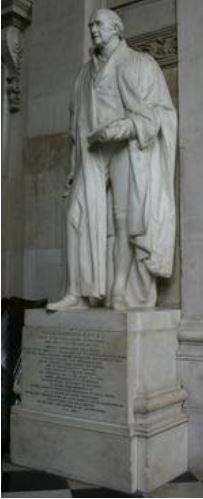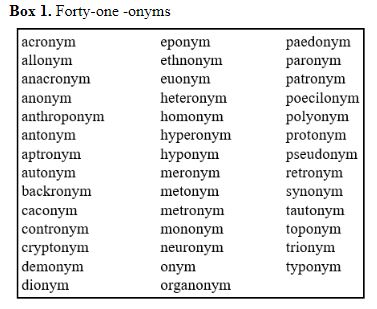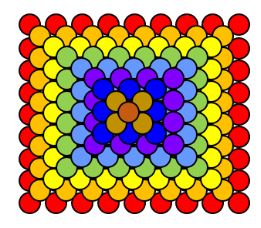Have you ever used a pseudonym? There are many reasons for doing so.
The word “pseudonym” comes from two Greek words:
- the combining form ψευδο- or ψευδ- before a vowel, seen in words such as ψευδής false, ψεῦδος a falsehood, ψεύδειν to deceive or cheat, and ψεύδεσθαι to be false or speak falsely;
- the Doric word ὄνυμα, a name, which when used as a suffix becomes –ωνυμον; in English it becomes -onym. The Attic form of the word was slightly different, ὄνομα. Used as a prefix it becomes ὀνομ-, as in onomatopoeia and onomastics, the study of names. An onomasticon is a dictionary of proper names and onomasiology is the study of words that are connected to names, like quixotic, dahlia and other plants, and minerals, such as babingtonite, named after the Irish physician and mineralogist, William Babington. Babington trained at Guy’s Hospital, where he became an apothecary and later chief physician (picture).
William Babington MD, FRS (1757–1833); fellow of the Royal College of Physicians. The inscription on his statue in St Paul’s Cathedral reads “Eminently distinguished for science; beloved for the simplicity of his manners, and the benevolence of his heart. Respected for his inflexible integrity, and his pure and unaffected piety. In all the relations of his professional life he was sagacious, candid, diligent, and humane, firm in purpose, gentle in execution; justly confident in his own judgment, yet generously open to the opinion of others; liberal and indulgent to his brethren but ever mindful of his duty to the public.”
One of his sons, Benjamin Guy, also became a physician at Guy’s and his daughter Martha married Richard Bright
The Oxford English Dictionary lists 41 words that end in –onym (Box 1). Many stories about pseudonyms are collected in Adrian Room’s onomasticon Naming Names (RKP, 1981).
Authors have often used pseudonyms. When female authors were poorly regarded, some published under male pseudonyms; Mary Ann Evans became George Eliot and Anne, Charlotte, and Emily Brontë became Acton, Currer, and Ellis Bell. Some men have published using female pseudonyms; Charles Hamilton, one of the most prolific authors of all time, best known as Frank Richards, the author of stories about Billy Bunter of Greyfriars School, used other names for stories about other schools; and when writing about Billy’s sister, Bessie, he became Hilda Richards. If you want to sell and your output is prodigious, it is wise to choose pseudonyms; John Creasey, whose output ran to over 600 novels, published them under his own name and 28 pseudonyms, including Anthony Morton and J J Marric. Charles Lutwidge Dodgson became Lewis Carroll to distinguish his literary and mathematical work.
Film stars have often disguised themselves to hide mundane or otherwise undesirable names. To hide his foreign origins, Emanuel Goldenberg became Edward G Robinson. Maurice Mickelwhite became Michael Caine and Archie Leach became Cary Grant; Frances Ethel Gumm became Judy Garland and Diana Mary Fluck became Diana Dors.
Those who enter religious orders change their names to signify spiritual rebirth. Popes originally took on assumed names because their own were regarded as pagan.
Crossword compilers have traditionally used pseudonyms, either based on their own names or to signify some aspect of their craft. When Edward Powys Mather, a scholar of Persian literature, started publishing his torturous puzzles in The Observer newspaper, he chose the name of one the Spanish inquisitors, Torquemada. His successor, Derrick MacNutt, a schoolmaster, chose another, Ximenes, and his successor, Jonathan Crowther, chose a third, Deza, but reversed it—Azed. Eric Chalkley, an admirer of Ximenes (known as “X”), called himself Apex. Colin Dexter called himself Codex and insisted that compilers’ pseudonyms should always include the letter X. My pseudonym for puzzles in the Times Literary Supplement is the name of an ancient Greek sculptor, and it contains an X and the letters TLS.
A recent phenomenon in the world of pseudonyms is their use to hide identities in social media. Such names may turn out to be noms de guerre rather than merely noms de plume. They can make contributors feel safe in penning pejorative comments, encouraging trolls. Conversely, it has been claimed that pseudonymity encourages activity and results in a better class of comments. However, even only a relatively small amount of unpleasantness generated by pseudonymity, would, in my view, strongly argue against its use, even if on the whole it was beneficial for social media. There are problems, however. While most such pseudonyms are obviously pseudonymous, one could, presumably, call oneself, say, “John Smith” and create an impenetrable false identity behind which to hide.
I am happy to engage with correspondents who write to me about things I have written, but not if they do so pseudonymously. If you want a discussion, tell me who you are.
Jeffrey Aronson is a clinical pharmacologist, working in the Centre for Evidence Based Medicine in Oxford’s Nuffield Department of Primary Care Health Sciences. He is also president emeritus of the British Pharmacological Society.
Competing interests: None declared.
|
This week’s interesting integer: 285 • Antiperfect numbers • 285 is the sum of different strings of integers: • 285 is a lucky number (see Interesting integer 261) • 285 is a sphenic number, the product of three distinct primes, 3 × 5 × 19; it is therefore equal to the volume of a cuboid with sides of those lengths. • 285 is a Harshad number (see Interesting integer 280), since it is divisible by the sum if its digits (15); divide 285 by 15 and the answer is a prime number, 19; that makes 285 a special kind of Harshad number, called a Moran number. • 285 is a Curzon number, one for which 2n + 1 is a divisor of 2n + 1; thus, 571 is a divisor of 2285 + 1. • 285 is the long leg of a primitive Pythagorean triangle: 682 + 2852 = 2932; it is also the short leg of a different Pythagorean triangle (2852 + 3802 = 4752) and the hypotenuse of yet another Pythagorean triangle (1712 + 2282 = 2852), but those two are merely multiples of a 3, 4, 5 triangle and are therefore not primitive. |



